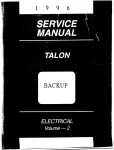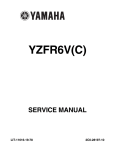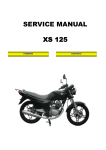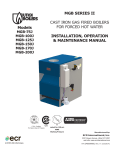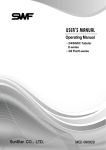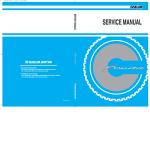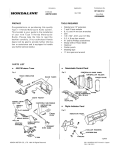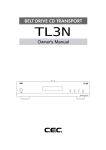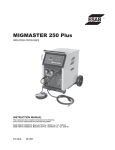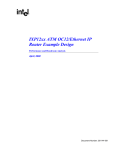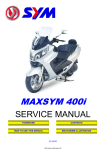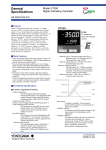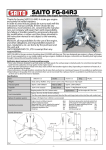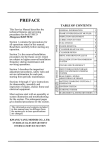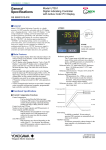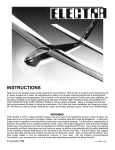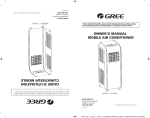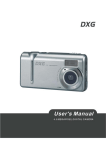Download troubleshooting - Honda Spree and Elite 50 Forums • Index page
Transcript
REAR WHEEL / BRAKE / SUSPENSION TROUBLESHOOTING Wobble or vibration in motorcycle Tire pressure incorrect Faulty tire Bent rim Loose wheel bearing Swing arm bushing worn Wheel out of balance Soft suspension Weak springs Rear damper improperly adjusted, oil leakage Hard suspension Rear damper improperly adjusted Bent shock absorber rod Suspension noise Loose fasteners Worn shock 11-2 REAR WHEEL / BRAKE / SUSPENSION REAR WHEEL REMOVAL Support the motor cycle on the main stand. Loosen the rear brake adjuster, and remove the brake cable. Remove the brake arm joint B. ADJUST ADJUST NUT NUT ADJUST NUT Remove the muffler. ( 3-7 ) Remove the rear wheel mud guard. Loosen the rear wheel U nut. Remove the washer. Remove the rear wheel. U-NUT U-NUT U-NUT INSPECTION Turn the wheel, and check the rim for wobbles. SERVICE LIMIT : Radical 2.0mm Axial 2.0mm INSTALLATION Insert the rear wheel over the final shaft. 11-3 REAR WHEEL / BRAKE / SUSPENSION Insert the washer, and tighten with the U nut. TORQUE VALUE : 6.0~8.0kgf m Install the brake arm joint B. Install the rear brake cable. Install the rear brake rod adjusting nut. Install the rear wheel mud guard. Install the muffler. Check the free play of the brake after the rear wheel assemblying REAR BRAKE Remove the rear wheel. ( 11-3 ) INSPECTION Measure the brake drum of inner diameter SERVICE LIMIT : 111mm Measure the thickness of the brake lining. SERVICE LIMIT : 2.0mm 11-4 REAR WHEEL / BRAKE / SUSPENSION REAR BRAKE DISASSEMBLY Manually open the brake shoe and remove it. Remove the shoe spring from the brake shoe. Loosen the rear brake arm fixing bolt. Remove the rear brake arm, rear brake indicator, brake cam, dust seal. Remove the rear brake cam. REAR BRAKE CAM REAR REAR BRAKE BRAKE CAM CAM REAR BRAKE CAM REAR BRAKE ASSEMBLY/INSTALLATION Apply small amount of grease to the brake cam. Install the brake cam. Install the rear brake dust seal, indicator, rear brake arm. Align the punch marks of the brake arm and the brake cam before assembly. Remove the excessive grease after assembling the shoe. REAR BRAKE CAM REAR REAR BRAKE BRAKE CAM CAM Install the brake shoe and spring. Install the rear brake shoe to the rear brake cam. Install the rear wheel. Install the washer and U nut. Check the brake for smooth operation. 11-5 REAR WHEEL / BRAKE / SUSPENSION REAR CUSHION REAR REAR CUSHION REAR CUSHION CUSHION REMOVAL Remove the luggage box. ( 3-3 ) Loosen the top and bottom rear cushion setting bolts. Support the frame firmly prior to working. SETTING SETTING BOLTS SETTING BOLTS BOLTS DISASSEMBLY Install the compressor attachment as shown in the figure. Install the cushion on the cushion compressor, and compress the spring. TOOLS : COMPRESSOR ATTACHMENT REAR COMPRESSOR Fix the bottom metal, and loosen the lock nut. Remove the bottom metal. Remove the stopper rubber, spring from the damper component. INSPECTION Measure the rear cushion spring free length. Check the damper rod for deflection or damage. SPRING FREE LENGTH 11-6 REAR WHEEL / BRAKE / SUSPENSION REAR CUSHION ASSEMBLY/INSTALLATION Assemble the spring, spring guide, and stopper rubber. Apply thread locking agent to the lock nut, and install the rear cushion compressor attachment on the damper rod. Fix the upper joint, and tighten the lock nut. TORQUE VALUE : 4.0kgf m TOOLS : REAR CUSHION COMPRESSOR REAR CUSHION COMPRESSOR ATTACHMENT INSTALLATION REAR REAR CUSHION REAR CUSHION CUSHION Install the rear cushion. Tighten the top and bottom of the cushion with bolt. TORQUE VALUE : UPPER SIDE 3.5kgf m LOWER SIDE 3.5kgf m SETTING SETTING BOLTS SETTING BOLTS BOLTS 11-7 BRAKE SYSTEM 12-0 12. BRAKE SYSTEM SERVICE INFORMATION TROUBLESHOOTING BRAKE FLUID/BLEEDING BRAKE PAD REPLACEMENT 12-1 12-1 12-3 12-4 BRAKE DISK INSPECTION BRAKE CALIPER MASTER CYLINDER 12-6 12-7 12-9 SERVICE INFORMATION GENERAL SAFETY Do not allow foreign material to enter the system when replenishing brake fluid. To prevent chemical changes, do not mix different types of brake fluid. Do not use the old brake fluid again. Brake fluid can cause damage to painted, plastic, and rubber surfaces. Take precaution not to allow parts to be contaminated by the brake fluid. Do not reuse sealing washers. Clean the disassembled parts with brake fluid, and check for any clogged passage with compressed air. Bleed the brake hose after removing it. TROUBLESHOOTING HYDRAULIC DISK BRAKE Braking power unsatisfactory Air in the brake system. Moisture in brake fluid Brake pad and disk contaminated. Caliper piston seal worn Master cylinder piston seal worn Brake pad worn Caliper inside contaminated Unsatisfactory caliper sliding part operation Lopsided wear of brake pad and disk Low brake fluid level Clogged brake fluid line Disk bent or distorted Caliper piston seized or worn Master cylinder piston seized or worn Disk worn Master cylinder inside contaminated Brake lever bent Hard brake lever movement or unsatisfactory return Brake system clogged Caliper piston seized or worn Unsatisfactory caliper sliding part operation Brake fluid line clogged Caliper piston seal worn Master cylinder piston seized or worn Brake lever bent Brake drag Brake pad and disk contaminated Improper wheel alignment Lopsided wear of brake pad and disk Disk bent or distorted Unsatisfactory caliper sliding part operation Hydraulic system contaminated with dust. 12-1 BRAKE SYSTEM MECHANICAL DRUM BRAKE Poor brake performance Improperly adjusted brake Worn brake linings Worn brake drum Worn brake cam Improperly installed brake linings Brake cable sticking/needs lubrication Contaminated brake linings Contaminated brake drum Worn brake shoes at cam contact areas Improper engagement between brake arm and camshaft serrations Brake lever hard or slow to return Worn/broken return spring Improperly adjusted brake Sticking brake drum due to contamination Worn brake shoes at cam contact areas Brake cable sticking/needs lubrication Worn brake cam Improperly installed brake linings Brake squeaks Worn brake linings Worn brake drum Contaminated brake linings Contaminated brake drum 12-2 BRAKE SYSTEM MASTER CYLINDER MASTER MASTER CYLINDER CYLINDER BRAKE FLUID/BLEEDING BRAKE FLUID CHANGE A contaminate disk or pad reduces braking power. Do not allow the disk or pad to be contaminated by oil. Replace contaminated pads, and remove pollutants from the disk completely. Check the brake fluid level often, and replenish new fluid as required. Do not spill fluid on painted, plastic or rubber parts. Remove the front handle cover. ( 3-6 ) Remove the master cylinder cap, master cylinder holder, and diaphragm from the master cylinder. Connect the bleeder hose to the bleeder valve. Loosen the bleeder valve, and pump the brake lever repeatedly. When there is no more fluid flowing out of the bleeder valve, stop pumping the brake lever. FRONT CALIPER FRONT FRONT CALIPER CALIPER FRONT CALIPER AIR BLEEDING BLEEDER VALVE Fill the reservoir with DOT 3 or 4 brake fluid up to the upper level. To prevent chemical changed, do not use different types of brake fluid. Connect the recommended brake bleeder to the bleeder valve. Loosen the bleeder valve while pumping the brake lever. Repeat this operation until the brake fluid flows out of the brake bleeder. Check fluid level often, and replenish fluid if the amount of fluid is reduced to the lower level. Read the user’s manual carefully prior to disassembling or using the brake bleeder. Protect the bleeder valve with tape to prevent air from entering the bleeder valve. Repeat the above operation until there is no air flowing out of the bleeder hose. Squeeze the bleeder valve and operate the brake lever to check the ingress of air. Add brake fluid. 12-3 BRAKE SYSTEM If the brake bleeder is not used, do the following, First, fill the brake fluid up to the upper limit line. Connect the hose to the bleeder valve to receive brake fluid. Squeeze the brake lever completely loosen the bleeder valve 1/2 turn, and tighten it again. Do not release the brake lever unitl the bleeder valve is tightened. Release the brake lever slowly to its fullest extent, and leave it unattended for a few seconds. Repeat the process specified in item and until there is no more air bubbles coming out of the bleeder valve. Check the fluid level often, and add fluid if the fluid level is near the lower level. If no air leaks out of the bleeder hose, operate the brake lever to check the presence of air. Assemble the bleeder valve. TORQUE : 0.6kgf m Add brake fluid up to upper level. Install diaphragm and mater cylinder cap. BLEEDER BLEEDER VALVE BLEEDER VALVE VALVE TORQUE VALUE : 1.0kgf m BRAKE PAD REPLACEMENT When replacing brake pads, replace whole set. Do not remove the brake hose when replacing brake pads. Loosen the hanger pin. Loosen the 2 front brake caliper fixing bolts from the front fork. Remove the front caliper. FIXING BOLTS FIXING FIXING BOLTS BOLTS FIXING 12-4 BRAKE SYSTEM To install a new brake pad into the brake, press the piston to return to the original position. Remove the hanger pin, pad shim, and brake pad. HANGER HANGER PIN HANGER PIN PIN BRAKE BRAKE PAD BRAKE PAD PAD Verify that the pad spring is installed in specific position. PAD SPRING PAD PAD SPRING SPRING PAD Install a new brake pad, pad shim, and hanger pin. HANGER HANGER PIN HANGER PIN PIN Install the brake caliper into the left front fork. Be careful not to damage the brake pad. Tighten the caliper braket bolt. TORQUE : 2.7kgf m 12-5 BRAKE SYSTEM Tighten the hanger pin. HANGER PIN PIN HANGER HANGER PIN BRAKE DISK INSPECTION Measure the thickness of the disk. SERVICE LIMIT : 3.0mm Measure the brake disk thickness at the several points and replace if the smallest measurement is less then the specified service limit. Check the brake disk for bent and twist. SERVICE LIMIT : 0.4mm Replace the brake disk if the disk for damage or cracks. BRAKE CALIPER REMOVAL Remove the brake oil bolts and the brake hose from the brake caliper. Remove the caliper from the L. front fork and remove the pad spring, hanger pin and brake pad. 12-6 BRAKE SYSTEM Pay attention not to let the brake fluid adhere to the parts because it can damage the painted surface. Wind the hose joint with cloth to prevent the brake fluid from leaking. Clean the removed parts with the brake fluid and make sure that the each port isn’t clogged with the compressed air. Keep the removed parts in order to avoid dust from adhering. DISASSEMBLY CALIPER CALIPER CALIPER CALIPER Remove the slide pin, the L. bracket, the pin bush, the boot and the pin boot, and the pin bolt from the caliper. If there is any wear or damage in the boot, replace it with the new one. Wind the caliper with cloth to prevent the piston or brake fluid from leaking. Remove the piston from the caliper while blowing the low-pressure air in the opening of the brake hose. AIR AIR GUN AIR GUN GUN Never use the high-pressure air or bring the air gun too close. Never touch the inside of the caliper DUST DUST SEAL DUST SEAL SEAL Disassemble the piston seal and the dust seal PISTON PISTON SEAL PISTON SEAL SEAL Pay attention not to damage the inner surface of the caliper. Clean the piston and the inside of the caliper and remove the oil from the seal groove. BRAKE CALIPER INSPECTION Caliper Cylinder Check the caliper cylinder bore for scoring, scratches or other damage. Measure the caliper cylinder I.D. in X and Y axis at serveral points. Replace the caliper cylinder if the largest measurement is beyond the specified service limit. CYLINDER CYLINDER CYLINDER GAUGE GAUGE GAUGE GAUGE SERVICE LIMIT : 27.10 mm CALIPER CALIPER CALIPER 12-7 BRAKE SYSTEM Caliper Piston CALIPER PISTON Measure the caliper piston O.D. in X and Y axis at several points. Replace the caliper piston of the smallest measurement is less than the specified service limit. SERVICE LIMIT : 26.84 mm MICROMETER BRAKE CALIPER ASSEMBLY/INSTALLATION LH. BRACKET LH. LH. BRACKET BRACKET LH. BRACKET PAD PAD PAD SPRING SPRING SPRING PSTON PSTON PSTON SEAL SEAL SEAL PIN PIN BUSH BUSH PIN BUSH PSTON PSTON PSTON PSTON DUST SEAL DUST DUST SEAL SEAL DUST SLIDE SLIDE PIN SLIDE PIN PIN Clean the piston seal and the dust seal with the brake fluid and install them in the caliper. Install the piston in the caliper with the groove side of the piston facing the pad. Make sure that each part is free from dust or dirt before reassembly. Replace the dust seals and piston seals as a set whenever they are removed. When cleaning with the brake fluid, use the specified brake fluid. Apply the silicone grease to the pin bush. Connect the pin bush to the portion of the caliper. Install the pad spring in the caliper. Install the caliper pin bolt and the slide pin in the caliper. Install the brake pad and the hanger pin in the caliper. BRAKE BRAKE PAD BRAKE PAD PAD Connect the brake hose to the caliper, and install 2 sealing washers and the brake hose bolt. TORQUE : 3.5kgf m Install the slide pin cap. Fill the brake fluid, and bleed air. 12-8 BRAKE SYSTEM MASTER CYLINDER MASTER CYLINDER MASTER MASTER CYLINDER CYLINDER REMOVAL Remove the back mirror. Remove the front handle cover. ( 3-6 ) Remove the rear handle cover. ( 3-6 ) Disconnect the front brake switch wire. Drain the brake fluid. Remove the brake hose from the master cylinder. Brake fluid causes damage to the painted, plastic or rubber parts. Do not spill fluid on these parts. If contaminated, gently wipe off the fluid with a piece of cloth or wash in water. Close hose joints properly to prevent leakage of brake fluid. Clean the disassembled parts with brake fluid, and use compressed air to verify each passage is not clogged. Do not allow the disassembled parts to be contaminated by waste material or dust. MASTER CYLINDER FRONT STOP SWITCH Remove the master cylinder holder, and lift out the master cylinder. DISASSEMBLY Remove the front stop switch. Remove the piston boot, cir clip from the master cylinder. TOOL : SNAP RING PLIERS Remove the washer, piston, spring from the master cylinder. Clean the master cylinder, reserve, master piston with the recommended brake fluid. MASTER CYLINDER INSPECTION Check the piston periphery for kink or scratch. Check the primary and secondary cups for wear. Measure the O.D of the master pin MASTER CYLINDER SERVICE LIMIT : 10.90 mm MICROMETER 12-9 BRAKE SYSTEM MASTER CYLINDER If there is any leak of fluid when installing new piston, it may indicate the side wear of the cylinder by the direction of the piston contacting face. In this case, the master cylinder must be replaced also. Check the master cylinder for scores, scratches or nicks and replace if necessary. Measure the master cylinder I.D. in X and Y axis at several points. SERVICE LIMIT : 11.08 mm CYLINDER GAUGE MASTER CYLINDER ASSEMBLY/INSTALLATION MASTER CYLINDER PRIMARY CUP SECONDARY CUP SNAP RING SPRING SPRING MASTER CYLINDER MASTER PISTON Replace the piston, spring, cups and snap ring as a set. Be sure that each part is free from dust or dirt before reassembly. When cleaning with the brake fluid, use the specified brake fluid. Coat the piston cup with the fresh brake fluid and install it on the piston. Install the spring with its larger diameter end toward the master cylinder. When installing the cups, do not allow the lips to turn inside out. (Refer to the drawing.) Note the installation direction of the snap ring. Be certain that the snap ring is seated firmly in the groove. Install the rubber boot in the groove properly. TOOL : SNAP RING PLIERS PRIMARY CUP MASTER CYLINDER MASTER MASTER CYLINDER CYLINDER MASTER CYLINDER Install the master cylinder to the handle bar. Install the holder with its “UP” mark facing upwards, and align the holder joint with the punch mark on the handle bar. Tighten the holder upper bolt first. 12-10 BRAKE SYSTEM MASTER CYLINDER MASTER MASTER CYLINDER CYLINDER Install the brake hose to the master cylinder with 2 new sealing washers and the hose bolt. TORQUE VALUE : 3.5kgf m Connect the brake stop swtich wire. Fill the brake fluid, and bleed air. Install the rear handle cover. ( 3-6 ) Install the front handle cover. ( 3-6 ) Install the back mirror. 12-11 MEMO 13. BATTERY/CHARGING SYSTEM SERVICE INFORMATION CHARGING DEVICES LOCATION TROUBLESHOOTING BATTERY REMOVAL/INSTALLATION BATTERY INSPECTION 13-1 13-2 13-3 13-4 13-4 CHARGING SYSTEM INSPECTION HEADLIGHT VOLTAGE INSPECTION REGULATOR/RECTIFIER INSPECTION A.C. GENERATOR RESISTER INSPECTION 13-4 13-6 13-6 13-7 13-9 SERVICE INFORMATION Do not place flammable materials near battery when charging. This can be a fire hazard as hydrogen gas is created during charging battery. Do not allow battery acid to come into contact with clothes, skin or eyes. Battery acid contact can cause burns or loss of eye sight. If contact occurs, thoroughly clean with water, and if acid enters eyes, flush with water and see a doctor. If battery acid gets on clothing, as it can seep through or make a hole through the clothing and make its way to the skin, make sure to change clothing that has come into contact with battery acid and wash the battery acid from the clothes. This vehicle has a maintenance-free(MF) battery. Because MF batteries use different charging equipment, take special care when performing maintenance and especially when replacing parts. Not all regular battery equipment is compatible with MF batteries. When charging the battery, remove the battery from the frame and do not open stopper. There is the possibility of damaging the regulator/rectifier, etc. if the terminal or coupler is separated/connected when electricity is over flowing through the electrical devices. Make sure to turn the main switch OFF when performing maintenance to the charging equipment. If the battery is allowed to repeatedly lose all its charge, is repeatedly over-charged, or if it is left in an un-charged state, the battery can be damaged, its life can be reduced, or it can lose some of its strength. It is important to note here that the battery will naturally last 2-3 years of noromal use, and although it will re-charge, its load is reduced, leading to a loss in battery strength. It is possible for the battery to become overcharged from battery body load. If a battery cell becomes short-circuited and if a state develops where voltage is not created between the terminals, the regulator will not operate and excessive voltage will develops where voltage is not created between the terminals, the regulator will not operate and excessive voltage will develop in the battery and normal cell electrolytes will decrease. If the vehicle is not used for a long period, make sure to chage the battery every three months. If not so, the battery ability to store electricity is reduced. A new MF battery will not necessarily be ready for use in the vehicle with only the adding of battery acid. Make sure to charge battery after the adding of battery water in the following instances : -When open voltage (voltage between terminals) does not reach 12.4V after the adding of battery water : charge until open voltage reaches at least 12. 8V. -When battery acid temperature is under 0 : charge normally for 2-3 hours. See the part location drawing for the location of charging system parts. ( 13-2 ) Follow the trouble shooting for charging equipment inspection. ( 13-3 ) The charging equipment may ofter appear to be malfunctioning if the couplers or connectors are incorrectly attached. Make sure to check these connections before starting maintenance work on the charging equipment. 13-1 CHARGING SYSTEM / AC GENERATOR CHARGING DEVICE LOCATION BATTERY RESISTER A.C. GENERATOR GREEN WHITE YELLOW RED RED GREEN A.C GENERATOR FUSE 7A REGULATOR/ RECTIFIER BATTERY (12V 3AH) AUTOBYSTARTER RESISTER (5W 6.7 ) RESISTER (30W 5.9 ) YELLOW YELLOW DIMMER SWITCH BLUE WHITE (HIGH) (LOW) HEADLIGHT (12V 35/35W) 13-2 SPEEDOMETER LIGHT (12V 3Wx2EA) YELLOW TAIL LIGHT (12V 5W) CHARGING SYSTEM / AC GENERATOR TROUBLESHOOTING Battery is Overcharged Headlight bulb is out. No headlignt beam wire. Headlight register is damaged (disconnected). Lighting switch is connected incorrectly. Regulator/rectifier is not grounded or connected incorrectly. Problems with the Charging System Measure battery voltage leakage. ABNORMAL Inspect the body of the register/rectifier. NORMAL Check charge level. UNDER 14V Check the voltage of the regulator/rectifier battery lines and the ground line. NORMAL OVER 15V OVER 14~15V ABNORMAL Short-circuited harness. Damaged main switch. Regulator/rectifier is damaged. Battery is damaged. ABNORMAL Wire harness is short-circuited. Coupeler is connected incorrectly. ABNORMAL Check the AC generator charging coil NORMAL Check the changing coil with the regulator/ rectifier coupler charging coil. NORMAL AC generator coupler connected incorrectly. NORMAL ABNORMAL Damaged charging coil. Check the lighting coil at the regulator/ rectifier coupler lighting coil line. ABNORMAL Inspact the AC generator charging/ lighting coil NORMAL NORMAL ABNORMAL AC generator coupler connected incorrectly. Damaged charging/lighting coil. Check the headlight lighting control voltage. ABNORMAL Damaged regulator/ rectifier (darkened headlight) ABNORMAL Damaged headlight register. ABNORMAL Damaged regulator/ rectifier. NORMAL Inspect the headlight register. NORMAL Inspect the body of the register/rectifier. NORMAL Damaged Battery 13-3 CHARGING SYSTEM / AC GENERATOR BATTERY REMOVAL/INSTALLATION SETTING SETTING BOLT SETTING BOLT BOLT Loosen the battery cover setting bolt. Remove the battery cover. After removing the negative “ ” terminal of battery firstly, must remove the positive “ ” terminal of battery. Install in the reverse order of removal. BATTERY INSPECTION CHARGE LEVEL (OPEN-CIRCUIT VOLTAGE) INSPECTION Remove the battery cover and disconnect the battery terminals. Measure the voltage between the battery terminals. - FULLY CHARGED : 13.0-13.2V - INSUFFICIENTLY CHARGED : Under 12.3V Use a digital voltmeter when measuring charge level. Measure 30minutes later. TOOL : DIGITAL CIRCUIT TESTER CHARGING SYSTEM INSPECTION LEAK TEST Trun off the main switch, and remove the earth cable from the battery. Connect an ampere meter between the battery terminal and the earth cable, and check current when the main switch is turned off. Use an ampere meter while sequentially changing its measuring range from large to small. If the current level greater than the measuring limit is measured, the ampere meter fuse may be cut. Do not turn on the main switch while current is being measured. LEAK CURRENT : Not to exceed 1mA BATTERY ADJUSTMENT VOLTAGE CHECK Connect the voltmeter between the battery terminals. Connect the amperemeter between the main fuse termanals. Start the engine and measure the charging voltage and ampere while incresae the rpm gradually. AMPERE METER BATTERY EARTH CABLE 13-4 CONTROL VOLTAGE (CHARGING SIDE) : 14.5 0.5V/5,000rpm (LAMP SIDE) : 13.1~ 0.5V/5,000rpm TERMINAL Check with fully charge the battery which has the voltage between terminal of 12.8~13.0V. In case that the engine is started by the starter motor, measurement must be performed after accelating (charging) for 10 seconds. CHARGING SYSTEM / AC GENERATOR CHARGING VOLTAGE CHECK VOLT METER AMPERE METER MAIN FUSE TERMINAL Use the full change battery (12.8~13.2V) In case that charging the voltage is not controled properly, the battery cannot be used due to the battery solution dried up by over charging and the deformation caused by the damage of the plates. Battery control voltage : 14.5 0.5V(5,000rpm) If you have 1EA of tester, measure current first. MAIN FUSE FILLER CAP CHARGING CURRENT CHECK SAFETY VENT FILTER Check the charging current passed through the generator assy, regulator comp is normal with the discharged battery. CHARGING CURRENT : 1.5~2.4A/5,000rpm TOOL : DIGITAL CIRCUIT TESTER BATTERY CHARGING Remove the battery from the frame, and connect it to the battery charger. -Connect the charger positive (+) cable to the battery positive (+) terminal. -Connect the charger negative (-) cable to the battery negative (-) terminal. PLATE SEPARATOR PLATE Do not connect the charger to the battery coupler terminals. Never open the sealed filler cap. BATTERY CHARGER The battery generates hydrogen gas which can be highly explosive. Do not smoke or allow flames or sparks near the battery, easpecially while charging it. Turn power ON/OFF at the charger, not at the battery terminals. If the cable is disconnected or connected at the battery terminal during charging, spark may jump and ignite the flammable gas. Always remove the battery from the frame when charging it. If the battery is charged while installed in the frame, the electrolyte may spill and corrode the frame components. CHARGING CURRENT : 0.3A CHARGING TIME : 8~10h Do not let the electrolyte temperature rise above 45 (113 ). If the electrolyte temperature becomes too high, lower the charging current. Quick-charging will shorten the battery life and cause battery damage. It chould only be done in emergency; slow-charging is prefered. 13-5 CHARGING SYSTEM / AC GENERATOR HEADLIGHT VOLTAGE INSPECTION Remove the front cover. ( 3-5) Check voltage with the headlight coupler connected. After starting the engine, place the dimmer switch to HI and check the voltage between the blue (+) and green (-) wires of the headlight coupler. Measurement is performed in AC area. CONTROL VOLTAGE : 12.6~13.6V/5,000rpm If voltage is incorrect, check the regulator/rectifier. REGULATOR/RECTIFIER INSPECTION HARNESS CIRCUIT INSPECTION Remove the front cover. ( 3-5 ) Remove the 4P coupler of the regulator/rectifier and inspect the wiring circuit in the main harness side terminal. ITEM MEASUREMENT LOCATION BATTERY WIRE Voltage between red “ ” and green “ ”. LEVEL AREAS OF INSPECTION IF INCORRECT There must be battery voltage. Damaged, disconnected main fuse/harness. CHARGING Resistance between white wire and COIL earth wires. Disconnect the starter. AC generator (charging, lighting coil Resistance between yellow wire and coupler connection damage) resister(6.7 LIGHTING COIL Inspect earth wires. Disconnect dimmer 0.4~1.0 (20 ) 5W) headlight lighting circuit. 0.2~0.8 (20 ) switch connection part after at least 10 minutes later. REGULATOR/RECTIFIER INSPECTION (BATEERY TERMINAL) (LAMP TERMINAL) TERMINAL ARRANGEMENT If the inspection of the harness side proves to be satisfactory, check the regulator/rectifier coupler for faulty connection, and measure the resistance between the terminals of the regulator/rectifier. RESISTANCE VALUE Tester Tester A L A (EARTH TERMINAL) 13-6 5-100 B E E 3-50 L (CHARGING TERMINAL) B 5-100 CHARGING SYSTEM / AC GENERATOR A.C. GENERATOR COOLING FAN FAN COOLING COOLING FAN REMOVAL NUT NUT NUT Remove the luggage box. ( 3-3 ) Remove the plug maintenance cover. ( 3-3 ) Remove the center cover. ( 3-3 ) Remove the floor side cover. ( 3-4 ) Remove the floor panel. ( 3-4 ) Remove the engine hanger side RH. cover. ( 3-5 ) Remove the plug cap. Loosen the 3 washer screws, remove the fan cover and the fan cover element A,B. Remove the fan cover rubber. Loosen the 2 flange bolts, remove the fan cover. Loosen the 4 cooling fan fixing flange bolts, remove the cooling fan. Hold the flywheel with a universal holder. TOOL : UNIVERSAL HOLDER Remove the flywheel with a ACG rotor puller. TOOL : ACG ROTOR PULLER 0750-00004 Remove the connector/coupler on the wire harness or starter motor. Remove the ground wires. FLYWHEEL FLYWHEEL FLYWHEEL FLYWHEEL Loosen the 2 pulse generator fixing flange bolts, remove the pulse generator. Loosen the 2 stator fixing flange bolts. Remove the grommet from the crankcase cover. Remove the stator. Insert the puller shaft and remove the flywheel after inserting the ACG rotor puller and securing it with spanner. The flywheel may easily removed if you rotate the puller while tapping the roller shaft with metal hammer. Always use a holder and a puller to remove the flywheel. Do not try to remove the flywheel by hammering directly on it. The crankshaft or components could be damaged. Remove the woodruff key with care not to lose it. ACG ACG ROTOR PULLER ACG ROTOR ROTOR PULLER PULLER WOODRUFF KEY CRANKSHAFT 13-7 CHARGING SYSTEM / AC GENERATOR STATOR INSTALLATION Note the direction of stator, and install the stator on the crankcase. Install the grommet to R. crankcase cover. Install AC generator wire coupler to wire harness. Install the connector to starter motor, then install the ground wire. STATOR COMP COMP STATOR STATOR COMP FLYWHEEL INSTALLATION Clean the tapered portion of the crankshaft. If the flywheel is installed with dust or dirt on the taper, the taper will not make secure contact with the flywheel and there will be excessive force on the woodruff key. Insert the woodruff key into the key groove in the crankshaft. Set the flywheel groove to the woodruff key and install the flywheel on the crankshaft. WOODRUFF WOODRUFF KEY WOODRUFF KEY KEY Before installing the flywheel, check that no nuts or bolts are magnetically attached to the flywheel. Installing the flywheel with anything attached to it could damage the stator coil. Hold the flywheel rotor with a holder and tighten the bolt (nut) to the specified torque. FLYWHEEL FLYWHEEL FLYWHEEL FLYWHEEL Install the cooling fan. Install the fan cover. Install the luggage box. ( 3-3 ) COOLING FAN COOLING FAN FAN COOLING 13-8 CHARGING SYSTEM / AC GENERATOR A.C. GENERATOR(CHARGING COIL) INSPECTION This test is done with the starter mounted to the engine. Remove the center cover. Disconnect the AC generator coupler. ( 3-3 ) Measure the resistance of the charging coil (between the white wire and ground) and the lighting coil (between the yellow wire and ground). STANDARD RESISTANCE (20 ) BETWEEN WHITE WIRE AND GROUND : 0.4~1.0 BETWEEN YELLOW WIRE AND GROUND : 0.2~0.8 RESISTER INSPECTION Remove the front cover. ( 3-5 ) Measure the resistance between the register lead wire and ground. STANDARD VALUE (20 ) RESISTER (6.7 5W) GREEN/BLACK/BODY GROUND : 6.3~7.1 RESISTER (5.9 30W)PINK/BODY GROUND : 5.6~6.5 Problems with the resister are caused by operational problems of the starter. 13-9 MEMO 14. IGNITION SYSTEM SERVICE INFORMATION IGNITION DEVICES LOCATION TROUBLESHOOTING IGNITION SYSTEM INSPECTION (PEAK VOLTAGE MEASUREMENT) IGNITION COIL 14-1 14-2 14-3 14-4 14-5 EXCITE COIL INSPECTION PULSE GENERATOR INSPECTION IGNITION TIMING INSPECTION CDI UNIT SIDE STAND IGNITION CUT-OFF SWITCH 14-6 14-6 14-7 14-7 14-8 SERVICE INFORMATION GENERAL SAFETY Refer to the malfunction diagnosis when inspecting ignition devices. Because the ignition devices have installed electrical advancer devices, it is impossible to adjust ignition timing. Be careful when handling the ignition devices as they can become easily damaged if dropped or bumped. Also, do not disconnect or connect the connectors and couplers when the main swtich is turned ON as excessive electric current can cause damage in the unit. Always perform maintenance work on the ignition devices with the main switch turned OFF. Ignition devices can often appear to be malfuctioning when the couplers or connectors are disconnected. Check these connections before working on. Use recommended spark plug. Using incorrect spark plug may make the engine run badly or damage the engine. This manual gives explanations on inspections to receive peak voltage. As inspections for coil resistance values are also included, it may be difficult to make a correct determination. Conduct inspection on the main swtich by referring to the wiring diagram continuity chart. ( chapter 16 ) 14-1 IGNITION SYSTEM IGNITION DEVICES LOCATION SPARK PLUG MAIN SWITCH CDI UNIT IG COIL A.C. GENERATOR BLUE/YELLOW GREEN BLACK/YELLOW BLACK/RED BLACK/WHITE A.C GENERATOR IGNITION COIL PULSE GENERATOR 14-2 CDI UNIT SIDE STAND SWITCH MAIN SWITCH SPARK PLUG IGNITION SYSTEM TROUBLESHOOTING Spark plug does not emit sparks. ABNORMAL STATE POSSIBLE CAUSES (START FROM 1 AND GO THROUGH LIST IN ORDER) IGNITION COIL PRIMARY VOLTAGE EXCITE COIL PULSE GENERATOR Maximum voltage is low. 1. Using a tester with a low internal resistance. 2. Cranking speed is low. Battery is low or kick power is weak. 3. Influence of tester sampling time (normal state if measured a number of times and shows over the set voltage). 4. Problem in ignition system wiring (disconnected, damaged). 5. Ignition coil is damaged. 6. Excite coil is damaged (measure peak voltage). 7. CDI unit is damaged (when no porblems in 1~6 and spark plug does not emit sparks) No, or almost no peak voltage. 1. Adaptor is connected incorrectly. 2.Main switch damaged. 3. CDI unit coupler is connected incorrectly. 4. CDI unit ground wire disconnection. 5. Damage to excite coil (measure peak voltage). 6. Pulse generator is damaged (measure peak voltage). 7. Peak voltage adaptor is damaged. 8. CDI unit is damaged (when no problems in 1~7 and no sparks emitted from spark plug). Spark plug peak voltage is normal but spark plug does not emit sparks. 1. Damage to spark plug or leakage of ignition coil secondary current. 2. Damaged ignition coil. Peak voltage is low. 1. Using a tester with a low internal resistance. 2. Cranking speed is too low. Battery is insufficiently charged or kick power is weak. 3. Influence of tester sampling time (normal state if measured a number of times and shows over the set voltage) 4. Excite coil is damaged (when 1~3 is okay). No, or almost no peak voltage. 1. Peak voltage adaptor is damaged. 2. Excite coil is damaged. Maximum voltage is low. 1. Using a tester with a low internal resistance. 2. Cranking speed is too low. Battery is insufficiently charged or kick power is weak. 3. Influence of tester sampling time (normal state if measured a number of times and shows over the set voltage). 4. Pulse generator is damaged (when 1~3 is okay). No, or almost no maximum voltage. 1. Maximum voltage adaptor is damaged. 2. Pulse generator is damaged. 14-3 IGNITION SYSTEM DIGITAL TESTER IGNITION SYSTEM INSPECTION (PEAK VOLTAGE MEASUREMENT) When sparks are not emitted from spark plug, after checking for disconnection in wires and looseness, measure peak voltage for each wire. Connect the peak voltage adaptor to the digital tester. DAELIM PVA MULTI TESTER PEAK VOLTAGE ADAPTOR IGNITION COIL IGNITION COIL PRIMARY VOLTAGE UNIT SIDE INITIAL TERMINAL Make sure each wire is correctly connected to ensure correct measurement. Inspect when there is cylinder compression pressure and with the spark plug cap securely connected to the spark plug. Remove the luggage box. ( 3-3 ) With the ignition coil wire connected, contact the peak voltage adaptor to the initial wire adaptor terminal (black/yellow) and ground (on vehicle body.). Turn the main swtich ON, operate the starter motor, and measure the ignition coil initial side peak voltage. CONTACT POINTS : BLACK/YELLOW TERMINAL “ ”-BODY EARTH “ ” PEAK VOLTAGE : OVER 120V When measuring voltage, do not touch the metal part of the handle rod as there is the danger of receiving an electric shock. EXCITE COIL Assemble the spark pug to the cylinder head, inspect in a state having compression pressure. WIRE HARNESS UNIT COUPLER CDI UNIT Remove the luggage box. ( 3-3 ) Remove the CDI unit. ( 14-7 ) Remove the coupler from the CDI unit contact the peak voltage adaptor to the excite coil wire (black/red and green) of the harness side coupler. Operate the starter motor and measure the excite coil peak voltage. CONTACT POINTS : BLACK/RED TERMINAL “ ”-BODY EARTH “ ” PEAK VOLTAGE : OVER 120V EXCITE COIL 14-4 When measuring voltage, do not touch the metal part of the handle rod as there is the danger of recieving an electric shock. IGNITION SYSTEM PULSE GENERATOR WIRE HANESS UNIT COUPLER Inspect with the spark plug assembled and while there is compression pressure. Remove the CDI unit. ( 14-7 ) Remove the coupler from the CDI unit and connect the peak voltage adaptor to the pulse generator wire (blue/ yellow and green) of harness coupler. Operate the starter motor and measure the peak voltage of the pulse generator coil. EXCITE COIL CONTACT POINTS : BLUE/YELLOW TERMINAL “ ”-BODY EARTH“ ” PEAK VOLTAGE : OVER 1.5V When measuring voltage, do not touch the metal part of the handle rod as there is the danger of receiving an electric shock. IGNITION IGNITION COIL IGNITION COIL COIL Perform the following inspections if measured peak voltage in the CDI unit coupler portion is abnormal. Disconnect the AC generator cord coupler and connect the adaptor. In the same manner as with the unit coupler side, measure peak voltage and compare with the first peak voltage. When the measured value in the unit side is abnormal and normal in the pulse generator side, the problem is either incorrect coupler connection or disconnection of the wire harness. When both measurements are abnormal, this indicates a problem with the pulse generator. Refer to the malfunction diagnosis are go through each step. IGNITION COIL REMOVAL/INSTALLATION FIXING FIXING SCREW FIXING SCREW SCREW Remove the luggage box. ( 3-3 ) Remove the plug maintenance cover. Remove the spark plug cap. Loosen the ignition coil fixing bolt. Disconnect the ignition coil wire. Remove the ignition coil. Install in the reverse order of removal. Arrange the cords in the right place. INSPECTION (RESISTANCE MEASUREMENT) Remove the luggage box. ( 3-3 ) Measure primary coil resistance between the green and black/yellow terminals. STANDARD VALUE : 0.1~0.5 (20 ) 14-5 IGNITION SYSTEM Measure the secondary coil resistance between the plug cap and green wire terminals. RESISTANCE VALUE (SPARK PLUG CAP CONNECTION) : 6.5~9.5 (20 ) The coil which the resistance value indicate “ ”(disconnection) remove the plugcap, and measure the resistance of secondary coil. Measure the resistance between the high tension code and green code terminals. RESISTANCE VALUE : 2.6 1.25 (20 ). EXCITE COIL INSPECTION Assembly the spark plug to the cylinder head, and inspect in an state having compression pressure. Remove the luggage box. ( 3-3 ) Remove the connection of the AC Generator wire connector (black/red), measure the resistance between the terminal of AC generator and body earth. STANDARD VALUE : 500 20 (20 ) PULSE GENERATOR INSPECTION The inspection of pulse generator is performed in a state assembling to the engine. Remove the luggage box. ( 3-3 ) Remove the connection of the AC generator 6P coupler, and measure the resistance between the blue/ yellow of starter and green code. STANDARD VALUE : 100 20 (20 ) IGNITION TIMING INSPECTION As a CDI device is used in this vehicle, there is no need for adjusting ignition timing. If ignition timing problems occur, inspect the CDI unit and the AC generator and replace if any malfunctions are found in the devices. Ignition timing inspection well read the instruction manual of timing light or revolution-indicator, and handle it exactly. 14-6 IGNITION SYSTEM Warm up the engine. Remove the center cover. Remove the floor panel. Remove the fan cover. Connect timing light to the high-tension cord. When engine rpms are at 1,800, ignition timing is correct if the “F” mark and crank case index mark are aligned. INDEX IGNITION TIMING : 17 DEGREES 2 BTDC/1,800 rpms F MARK Index mark must face the spark plug. CDI UNIT REMOVAL/INSTALLATION Remove the luggage box. ( 3-3 ) Disconnect the coupler from the CDI unit and remove CDI Unit. Install in the reverse order of removal. CIRCUIT INSPECTION Remove the coupler from the CDI unit, and check the ignition system circuits from the wiring coupler side. CDI UNIT CDI CDI UNIT UNIT CDI UNIT INSPECTION ITEM CHECK POINT PULSE GENERATOR BLUE/YELLOW AND GREEN STANDARD VALUE 50~200 (20 ) IGNITION COIL -PRIMARYCOIL BLACK/YELLOW AND GREEN 0.1~0.5 (20 ) -SECONDARY COIL GREEN AND HIGH-TENSION CORD (ATTACH THE PLUG CAP) 6.3~10.3K (20 ) (DETACH THE PLUG-CAP) 3.3 K (20 ) TESTING BY CDI TESTER Check the CDI unit spark performance by using a CDI tester. Read tester manual carefully prior to using the tester. SIDE STAND IGNITION CUT-OFF SWITCH INSPECTION SIDE STAND SWITCH SIDE SIDE STAND STAND SWITCH SWITCH SIDE Remove the plug maintenance cover/ center cover. ( 3-3 ) Remove the coupler of the side stand switch. Check for continuity between the terminal as shown below: 14-7 IGNITION SYSTEM ITEM TERMINAL SPECIFICATION ON (Side stand is Retracted) BLACK/WHITE AND GREEN NO CONTINUITY OFF (Side stand is Lowered) BLACK/WHITE AND GREEN CONTINUITY SIDE STAND SWITCH SIDE SIDE STAND STAND SWITCH SWITCH SIDE STAND SWITCH REMOVAL Remove the floor side cover. ( 3-4 ) Remove the plug maintenance cover/ center cover. ( 3-3 ) Remove the side stand switch mounting 2 bolts. Release the wire clamps and remove the side stand switch. INSTALLATION SIDE STAND STAND SIDE STAND SIDE SWITCH COUPLER COUPLER SWITCH COUPLER SWITCH FAN SCREW FAN FAN SCREW SCREW 14-8 Install in the reverse order of removal. 15. STARTING SYSTEM SERVICE INFORMATION STARTING DEVICES LOCATION TROUBLESHOOTING 15-1 15-2 15-3 STARTER MOTOR STARTER RELAY INSPECTION STARTER PINION GEAR INSPECTION 15-4 15-7 15-7 SERVICE INFORMATION GENERAL SAFETY When performing maintenance on the starter motor and related parts, turn the main switch to OFF. There is the danger of the starter motor unexpectedly operating if the main switch is not turned to OFF. First check connection with battery and battery charge level before beginning maintenance on the starter motor. It is possible for the starter motor coil to become damaged if the starter is operated when the engine does not turn over. 15-1 STARTING SYSTEM STARTING DEVICES LOCATION START SWITCH START RELAY MAIN SWITCH BATTERY 15-2 STARTING SYSTEM TROUBLESHOOTING Starter motor does not rotate (No response from starter motor). Check to see if the fuse is burned out. Check to turn on the lamp of stop switch. With the main switch turned to ON, squeeze the brake lever. In this state push the starter button and check if a clicking noise then an operating noise is emitted from the starter relay. Remove the starter motor “ ” wire, connect it to the battery “ ” terminal and check to see if the starter motor rotates (because a large amount of current flows in this test, do not use thin wire). CLICKS ROTATES NO CLICK. DOES NOT ROTATE Incorrect starter motor connecion Remove the coupler from the starter replay and inspect the relay coil ground wire. Incorrect starter motor Faulty starter switch. NO CONTINUITY. Incorrect connection with the switch terminals or harness disconnection. CONTINUITY. Check the starter relay voltage in the starter relay coupler with the coupler connected. NO VOLTAGE. Damaged main or starter switch. Incorrect connection with coupler connector. VOLTAGE MEASURED. Disconnection in starter switch wire. Faulty brake stop switch. Check the operation of the starter relay. ABNORMAL NORMAL Loose or poor contact at starter relay switch connector. Faulty starter relay switch. Starter motor rotates but crank shaft does’t Incorrect starting clutch. Incorrect starter gear. Starting clutch slip Starter motor operates in free-wheel Internal fault of starter motor Driven gear slips. Weak rotational power in starter motor Battery is insufficiently charged. Incorrect connection of battery terminal cord. Damaged starter motor. Ground wire is connected incorrectly Brush is damaged or worn. Starter motor and crank shaft rotate but does not turn engine over. Incorrect starting system. Faulty engine. 15-3 STARTING SYSTEM FIXING FIXING BOLT FIXING BOLT BOLT STARTER MOTOR REMOVAL/INSTALLATION Remove the luggage box. ( 3-3 ) Remove the center cover. ( 3-3 ) Remove the floor side RH. cover. ( 3-4 ) Disconnect the starter wire connector, remove the wire from the wire fixing clamp. Loosen the 2 starter motor fixing bolts. Remove the starter motor. Install in the reverse order of removal. Accurately tighten the earth wire. Turn off the main switch prior to servicing the starter motor. If power is connected, the starter motor may be activated and damaged. DISASSEMBLY Remove the starter motor screws and remove the motor cover. Record the order so the parts can be installed correctly later. INSPECTION Check for continuity of the starter motor case. -Between cord terminal“ ” and bracket“ ”: normal if no continuity. -Between cord terminal and brush (black wire) : normal if there is continuity. If abnormal, replace with a new one. Measure the brush length. Replace the brush if it is worn beyond the service limit. SERVICE LIMIT : 3mm 15-4 STARTING SYSTEM Check the commutator for : -Damage or abnormal wear. Replace with a new one. -Discoloration of the commutator bar. Replace with a new one. -Metallic debris between commutator bars. Clean it off. Check for continuity between pairs of commutator bars. Make a continuity check between individual commutator bars and the armature shaft. There should be no continuity. Check the bearings. -Do not rotate smoothly. Replace with a new one. -Loose bearing. Replace with a new one. STARTER MOTOR ASSEMBLY Carefully insert the armature shaft into the front bracket. Align the front bracket notch with the brush. The sliding surcfaces of the brushes can be damaged if they are not installed properly. 15-5 STARTING SYSTEM Insert the brush spring into the brush holder and install the front bracket. Insert the brush spring with care so that it does not lean in the holder. Apply grease to both ends of the armature shaft. Install the starter motor cover. The coil may be damaged if the magnet pulls the armature against the case. Align the front bracket with the cover. Tighten the washer screw. 15-6 STARTING SYSTEM STARTER RELAY INSPECTION STARTER RELAY BATTERY SWITCH Remove the luggage box. ( 3-3 ) When battery voltage is applied between the starter relay green/yellow wire and yellow/red terminals, there should be continuity between the red and red/white terminals. The terminals are distinguished by the corresponding wire color of the wire harness connector. STARTER PINION GEAR INSPECTION Remove the L. side cover. ( 7-2 ) Remove the drive face. ( 7-6 ) Remove the starter pinion gear. Install in the reverse order of removal. STARTER STARTER PINION GEAR STARTER PINION PINION GEAR GEAR DRIVE DRIVE FACE DRIVE FACE FACE INSPECTION STARTER PINION Wear or damage to the pinion, reduction gears. Replace with a new one. Worn journals. Replace with a new one. REDUCTION GEAR PINION GEAR Check if the pinion gear moves smoothly along the axis. Pinion gear does not move smoothly. Replace with a new one. 15-7 MEMO 16. LIGHTS/METER/SWITCHES SERVICE INFORMATION TROUBLESHOOTING FUEL UNIT OIL LEVEL SWITCH MAIN SWITCH 16-1 16-1 16-2 16-3 16-3 HANDLE SWITCH INSPECTION FRONT STOP SWITCH INSPECTION BULBS REPLACEMENT METER REPLACEMENT HORN INSPECTION 16-4 16-4 16-5 16-6 16-7 SERVICE INFORMATION GENERAL SAFETY Refer to tester owner’s manuals when performing continuity inspections. Refer to wiring diagram (chapter 17) for switch continuity. After inspecting and/or performing maintenance work make sure the wires and cables are properly placed and connected. TROUBLESHOOTING Fuel meter indicator malfunctioning Coupler separated. Harness disconnected. Float operation malfuction. Fuel unit damaged. Meter damaged. Fuel meter needle unstable Coupler loose. Fuel unit damaged. Meter damaged. Headlight hi-lo not operating Oil indicator light not operating (when there is oil). Burned out fuse. Battery insufficiently charged. Main swtich damaged. Meter damaged. Oil level switch damaged. Loose connector. Harness disconnection. Oil indicator does not turn off (when oil is out) Oil level switch damaged. Green/red wire joined. Bulb malfunction. Dimmer switch damaged. 16-1 LIGHTS/METER/SWITCHES FUEL UNIT FUEL FUEL UNIT UNIT SET SET CAP CAP FUEL UNIT SET CAP REMOVAL Remove the luggage box. ( 3-3 ) Remove the fuel unit wire from the wire harness. Turn the fuel unit fixing unit set cap comp to the left, and remove it. Remove the fuel unit from the fuel tank. Be careful of prevention the fuel unit wire from damaging. When disassembling, be careful of prevention the float arm from damaging. FUEL FUEL UNIT FUEL UNIT UNIT BASE PACKING BASE BASE PACKING PACKING BASE PACKING Remove the base packing. Check for damage. INSTALLATION Install the base packing to the fuel tank. Install the fuel unit. Install it aligning the part of the fuel unit with the loop part of fuel tank. Check the fuel leakage. INSPECTION Move the float upward and downward, and measure the resistance between the terminals. WIRE TERMINAL FLOAT 16-2 FLOAT UPPER LINE FLOAT LOWER LINE GREEN AND YELLOW/WHITE 33 400~750 GREEN AND BLUE/WHITE 400~750 33 BLUE/WHITE AND BLUE/WHITE 450~750 450~750 When the measured value differs greatly from the standard value, replace the fuel unit. LIGHTS/METER/SWITCHES OIL LEVEL SWITCH OIL OIL LEVEL SWITCH OIL LEVEL LEVEL SWITCH SWITCH REMOVAL/INSTALLATION Remove the luggage box. ( 3-3 ) Remove the body cover. Loosen the bolt jointed with the fuel tank. Remove the wire of oil level switch. Remove the oil level switch from the oil tank. Install in the reverse order of removal. OIL OIL TANK TANK OIL TANK Disassemble after adjusting the oil level. INSPECTION Move the float to farthest extreme up and down and check the continuity of the terminals. It’s normal state if there is no continuity when the float is up, but continuity when it is down. FLOAT MAIN SWITCH REMOVAL/ INSTALLATION Remove the front cover. ( 3-5 ) Remove the inner box. ( 3-5 ) Disconnect the main switch coupler. Remove the seat lock cable. Loosen the 2 screws and remove the main switch. Install in the reverse order of removal. MAIN SWITCH SWITCH MAIN MAIN SWITCH INSPECTION Inspect continuity of each terminal. TERMINAL ON OFF LOCK COLOR BLACK/WHITE GREEN RED BLACK 16-3 LIGHTS/METER/SWITCHES HANDLE SWITCH INSPECTION Remove the front handle cover. ( 3-6 ) Remove the handle switch coupler, connector, and inspect continuity of each terminal. If abnormal, inspect the switch. STARTER SWITCH LIGHTING SWITCH LIGHTING SWITCH LIGHTING LIGHTING SWITCH SWITCH OFF FREE (N) PUSH PO COLOR YELLOW/RED GREEN (N) H BROWN COLOR / WHITE BROWN YELLOW PINK STARTER SWITCH STARTER STARTER SWITCH SWITCH DIMMER DIMMER SWITCH DIMMER SWITCH SWITCH WINKER SWITCH DIMMER SWITCH LO L N N HI R COLOR BROWN WHITE BLUE COLOR SKY BLUE ORANGE GRAY HORN SWITCH FREE WINKER WINKER WINKER SWITCH SWITCH SWITCH PUSH COLOR LIGHT GREEN BLACK HORN HORN SWITCH HORN SWITCH SWITCH FRONT STOP SWITCH INSPECTION Remove the front handle cover. ( 3-6 ) Remove the black wire and green/yellow wire terminals inside the speedometer assembly, and check the following. -When the brake lever is pulled - continuity. -When the brake lever is released - no continuity. STOP SWITCH FRONT STOP STOP SWITCH SWITCH FRONT FRONT STOP SWITCH 16-4 LIGHTS/METER/SWITCHES BULBS REPLACEMENT HEADLIGHT BULB Remove the front cover. ( 3-5 ) Remove the headlight rubber cover. Push down on the socket and turn to the left. Replace with new bulb. HEADLIGHT HEADLIGHT RUBBER COVER HEADLIGHT RUBBER RUBBER COVER COVER HEADLIGHT BULB HEADLIGHT HEADLIGHT BULB BULB HEADLIGHT BULB Before replacing the bulb, be sure to check the swtiches for loose connection of the connectors. Install in the reverse order of removal. Headlight bulbs become very hot while the headlight is ON, and remain hot for a while after they are turned OFF. Be sure to turn the ignition switch OFF and let the bulb cool down before replacement. If you touch the bulb with your bare hands, clean it with a cloth moistened with denatured alcohol to prevent early bulb failure. Be sure to install the dust cover after replacing the bulb. FRONT WINKER BULB Remove the front cover. ( 3-5 ) Remove the bulb from the socket, replace with new bulb. Install in the reverse order of removal. PAN PAN SCREW PAN SCREW SCREW 16-5 LIGHTS/METER/SWITCHES REAR WINKER BULB REPLACEMENT Press the winker lens groove and open the winker lens using plain screwdriver. Remove the bulb from the socket, replace with new bulb. Install in the reverse order of removal. Pay attention not to damage the lens. Do not apply excessive force when removing the lens. PAN SCREW PAN PAN SCREW SCREW PAN TAILLIGHT BULB REPLACEMENT Loosen the 2 pan screws, remove the tail light lens. Replace the tail stop light bulb with the new one. Pay attention not to damage the tail light lens when removing it. PAN SCREW PAN PAN SCREW SCREW PAN METER BULB REPLACEMENT BULB BULB BULB BULB Remove the front handle cover. ( 3-6 ) Remove the bulb socket, replace with new bulb. SPEEDOMETER SPEEDOMETER SPEEDOMETER SPEEDOMETER METERS REPLACEMENT Remove the front cover. ( 3-5 ) Remove the front handle cover. ( 3-6 ) Remove the front/rear stop swtich wire. Remove the speedometer cable from the meter. Loosen the 4 steering handle tapping screws. Remove the speedometer coupler connected to the wire harness Remove the speedometer wiring from the steering handle cable guide. Remove the speedometer and the gear handle cover assemblied from the steering handle. Roose the 3 tapping screws securing the speedometer and the rear handle cover. Disconnect the R/L wiring. Remove the speedometer assembly. Install in the reverse order of removal. 16-6 LIGHTS/METER/SWITCHES Check the each switch for proper operation. The wire and cable must be connected accurately. HORN HORN HORN HORN HORN INSPECTION Remove the front cover. ( 3-5 ) Remove the horn wiring, and connect a fully charged 12V battery. Check the sound quality for any abnormalities. LICENCE LAMP Loosen 2 screws. Remove the lamp cover. Replace the lamp (12V 4W) Install in the reverse order of removal. LICENCE LICENCE LAMP LICENCE LAMP LAMP BULB BULB BULB BULB 16-7 MEMO 17. WIRING DIAGRAM 17-1 WIRING DIAGRAM 18. TROUBLESHOOTING ENGINE DOES NOT START OR IS HARD TO START 18-1 ENGINE OUTPUT INSUFFICIENT 18-2 POOR PERFORMANCE AT LOW SPEED AND IDLING POOR PERFORMANCE AT HIGH SPEED UNSATISFACTORY OPERATION FUEL GAUGE STARTER MOTOR 18-3 18-3 18-4 18-6 18-7 ENGINE DOES NOT START OR IS HARD TO START CAUSE OF TROUBLE 1. Open the drain screw, and check fuel flow to the carburetor. Fuel not supplied to the carburetor. (1)Fuel tank empty. (2)Fuel tube up to the fuel tank clogged, or the vacuum tube or fuel tube up to the inlet pipe clogged. (3)Float valve clogged. (4)Fuel tank cap air hole clogged. (5)Fuel supply pipe frozen. (6)Fuel strainer clogged. Weak or no spark. (1)Faulty spark plug. (2)Contaminated spark plug. (3)Faulty CDI unit. (4)Faulty A.C. generator. (5)Disconnected or shorted high tension cord. (6)Disconnected or shorted ignition coil. (7)Faulty main switch. Low cylinder pressure. (1)Piston ring seized. (2)Cylinder and piston ring won. (3)Cylinder and cylinder head cracked. (4)Crank case air leaks. (5)Cylinder head gasket damaged. Engine starts but stops immediately. (1)Manifold air leaks. (2)Inadequate ignition timing. Plugs wet. (1)Carburetor flooded. (2)Faulty control box. (3)Throttle valve excessively opened. Fuel is supplied. 2. Check spark plugs. Good spark 3. Test cylinder pressure. Pressure normal 4. Start engine in the following procedure. Engine will not start. 5. Remove spark plugs. Dry plugs 18-1 TROUBLESHOOTING ENGINE OUTPUT INSUFFICIENT CAUSE OF TROUBLE 1. Gently accelerate engine. Engine speed increases. 2. Check ignition timing. Engine speed does not increase sufficiently. (1) Air cleaner clogged. (2) Insufficient fuel supply. (3) Fuel tank cap air hole clogged. (4) Muffler clogged. Abnormal (1) Faulty CDI unit. (2) Faulty A.C generator. Low (1) Cylinder and piston ring worn. (2) Cylinder head gasket damaged. (3) Cylinder and cylinder head cracked. Clogged. (1) Unsatisfactory carburetor maintenance. Contaminated or discolored. (1) Unsatisfactory plug maintenance. (2) Plugs with incorrect heat value used. (3) Rich fuel mixture. Overheated. (1) Cylinder or piston worn. (2) Lean fuel mixture. (3) Poor quality fuel used. (4) Carbon deposit inside the combustion chamber excessive. (5) Ignition timing incorrect. Engine knocks. (1) Carbon deposit inside the combustion chamber excessive. (2) Poor quality fuel used. (3) Lean fuel mixture. Normal 3. Press the kick starter pedal to check the cylinder pressure. Normal 4. Check the carburetor for clogging. Not clogged. 5. Remove spark plugs. Not contaminated or discolored. 6. Check for engine overheating. Not overheated. 7. Accelerate suddenly or run at. Engine does not knock. 18-2 TROUBLESHOOTING POOR PERFORMANCE AT LOW SPEED AND IDLING CAUSE OF TROUBLE 1. Check ignition timing. Abnormal (1) Faulty CDI unit. Incorrect (1) Excessive fuel mixture. (Loosen screw to correct adjustment level.) (2) Lean fuel mixture. (Tighten screw to correct adjustment level.) Leaking (1) Faulty insulator packing. (2) Loose carburetor. (3) Faulty inlet pipe packing. (4) Faulty insulator O-ring. Weak or intermittent sparks. (1) Carbon deposited on spark plugs or spark plugs contaminated. (2) Faulty CDI unit. (3) Faulty ignition coil. (4) Faulty A.C. generator. (5) Faulty main switch. Normal 2. Check the carburetor air screw. Correct 3. Check the area around the manifold for air leakage. No leak. 4. Check sparks. Sparks normal. POOR PERFORMANCE AT HIGH SPEED CAUSE OF TROUBLE 1. Check ignition timing. Incorrect (1) Faulty CDI unit. (2) Faulty A.C. generator. Insufficient fuel supply. (1) Fuel tank empty. (2) Fuel tube or fuel filter clogged. (3)Fuel tank cap air hole clogged. Clogged. (1) Clean. Correct 2. Remove the fuel tube from the fuel valve. Fuel flows. 3. Remove the carburetor, and check for clogged jets. Not clogged. 18-3 TROUBLESHOOTING UNSATISFACTORY OPERATION CLUTCH DRIVE/DRIVEN PULLEY CAUSE OF TROUBLE 1. Engine starts but motorcycle does not move. (1) Drive belt worn or slips. (2) Ramp plate damaged. (3) Drive face spring damaged. (4) Clutch lining came off. (5) Driven pulley shaft spline damaged. (6) Faulty transmission. (7) Transmission seized. 2. Vehicle moves slow, engine starts but stops immediately. (1) Shoe spring damaged. (2) Clutch outer and weight seized. (3) Pivot seized. 3. Engine weak at start. (1) Drive belt worn or slips. (2) Weight roller worn. (3) Drive pulley bearing seized. (4) Weak drive face spring. (5) Drive pulley bearing worn or seized. 4. Engine weak at high speed. (1) Drive belt worn or slips. (2) Weight roller worn. (3) Drive pulley bearing worn. 5. Abnormal noise or odor. (1) Oil or grease spilled on the drive belt and inside pulley. (2) Drive belt worn. (3) Weak drive face spring. (4) Driven pulley bearing worn or seized. POOR MECHANICAL PERFORMANCE Check tire pressure. CAUSE OF TROUBLE 1. Steering is heavy. (1) Steering head adjuster excessively tightened. (2) Steering cone race or steel ball damaged. 2. Wheels wobbling. (1) Excessive wheel bearing play. (2) Rim bent. (3) Axle nut loose. 3. Motorcycle pulls to one side. (1) Front wheel and rear wheel not aligned. (2) Front fork bent. 18-4 TROUBLESHOOTING POOR FRONT/REAR SUSPENSION PERFORMANCE Check tire pressure. CAUSE OF TROUBLE 1. Suspension excessively soft. (1) Cushion spring weak. (2) Overloaded. (3) Damper oil leaks. 2. Suspension excessively hard. (1) Fork pipe or cushion rod bent. 3. Noise from the suspension. (1) Sliders stuck. (2) Cushion stopper rubber damaged. POOR BRAKE PERFORMANCE Check brake adjustment. CAUSE OF TROUBLE 1. If the arrow were mark and the brake panel mark match with each other. (1) Brake shoe worn. (2) Brake cam worn. (3) Shoe and cam contact surface worn. (4) Brake drum worn. 2. Brake noise. (1) Brake shoe worn. (2) Foreign matter in the brake lining. (3) Brake drum and shoe contact surface curved. 3. Poor braking. (1) Brake wire defective or expanded. (2) Only part of the brake shoe makes contact with the brake drum. (3) Clay or moisture inside the brake drum. (4) Brake lining contaminated by grease or oil. 18-5 TROUBLESHOOTING FUEL GAUGE GAUGE READING INACCURATE (IGNITION SWTICH ON) 1. Operate the turn signal to check the battery circuit. Signal operates satisfactorily. 2. Remove the fuel level sensor, and move float to check the status of operation. CAUSE OF TROUBLE Signal continuously operates dim or does not operate at all. (1) Fuse cut. (2) Battery weak or totally discharged. (3) Faulty ignition swtich. (4) Faulty terminal connection. (5) Wire harness damaged. Needle moves. (1) Faulty float. Needle not moving. (1) Balance coil damaged or shorted. Unsatisfactory (1) Terminal loose. (2) Faulty terminal connection. Float up : Full position Float down : Empty position Needle not moving. 3. Short-circuit the tank unit terminal on the wire harness side. Needle not moving. 4. Terminal joints loose or faulty connection. (1) Balance coil/lead shorted or damaged. Check GAUGE NEEDLE SHAKES OR VERTICALLY WOBBLES. (IGNITION SWTICH ON) 1. Operate the turn signal to check the battery circuit. Signal operates satisfactorily. 2. Remove the tank and operate the float. CAUSE OF TROUBLE Signal continuously operates dim or does not operate at all. (1) Fuse cut. (2) Battery weak or totally discharged. (3) Ignition switch damaged or shorted. (4) Terminal loose of faulty connection. (5) Wire harness damaged. Needle not moving. (1) Faulty fuel level sensor connection. Needle not moving. (1) Damper oil inside the meter insufficient. Resistance changed significantly. (1) Faulty connection between the sliding arm and the resistance. Unsatisfactory (1) Terminal connection loose or faulty connection. Needle moving. 3. Move the float rapidly. One up/down motion per second. Needle moving. 4. Start the engine, and measure the fuel level sensor resistance. Resistance not changed. 5. Check each joint. Satisfactory 18-6 (1) Balance coil/lead shorted or damaged. TROUBLESHOOTING STARTER MOTOR STARTING MOTOR WILL NOT TURN 1. Apply the brake and check the brake stop light for operation. Light not activated. (1) Fuse cut. (2) Battery weak or totally discharged. (3) Faulty stop switch. (4) Faulty terminal connection. (5) Ignition swtich damaged or shorted. Signal continuously operates dim or does not operate at all. (1) Battery totally discharged. Unsatisfactory (1) Faulty starter switch connection. (2) Starter magnetic damaged or shorted. (3) Connector and terminals loose. Starter does not turn. (1) Worn brush worn. (2) Faulty connection between the rotor and brush. (3) Faulty the starter motor subwire connection. (4) Terminal loose. Light is activated. 2. Operate the turn signal to check the battery circuit. Signal operates satisfactorily. (60~120 signaling/second) 3. Press the starter switch to check the starter magnetic. Satisfactory 4. Connect the starter to battery and check operation. Light not activated. CAUSE OF TROUBLE Starter turns. (1) Wire harness damaged. STARTER MOTOR TURNS SLOW OR FAILS TO CRANK MOTOR 1. Operate the turn signal to check the battery circuit. Signal operates satisfactorily. 2. Connect the starter subwire to the battery. CAUSE OF TROUBLE Signal continuously operates dim or does not operate at all. (1) Battery totally discharged. Operates sitisfactory. (1) Connector/terminal loose. (2) Faulty starter relay connector. Operates heavy. (1) Engine seized. Turns slowly. (with speed not changing) 3. Operate the kick starter. Operates light. (1) Faulty connection between the rotor and brush. STARTER ROTATE WITHOUT STOPPING CAUSE OF TROUBLE 1. Turn off the ignition switch. (1) Pinion seized. Will not stop Starter relay connection seized. 18-7 MEMO































































